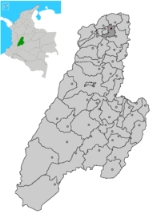
Falan
Encyclopedia
Falan is a town and municipality in the Tolima department of Colombia
. Falan was founded before 1539, by the Guandecas and Pomponáes tribes. It was discovered by Spanish
Baltazar Maldonado in 1539. The population of the municipality was 17,251 as of the 1993 census. The total area of the municipality is 238 km². Most workers work in agriculture
although some do logging
or mining
. The altitude is 930 meters above sea level.
Falan was originally inhabited only by indigenous inhabitants. In the middle of the 16th century, Spanish conquistadors first came across Falan. Spanish settlers came in the mid 18th century, seeking to extract silver and gold from the nearby mines, they called the community Rosario de Lajas. A nearby mine that much ore was brought out of was named Santa Ana, and soon the community began to be called by that name. In 1930, the municipality changed its name once again to Falan, in honor of the poet Diego Fallon who had been born in the region.
The local economy of Falan, produces coffee, cacao, yucca, maize, panelera cane, banana, and fruits. In addition, wood is harvested throughout the municipality.
Colombia
Colombia, officially the Republic of Colombia , is a unitary constitutional republic comprising thirty-two departments. The country is located in northwestern South America, bordered to the east by Venezuela and Brazil; to the south by Ecuador and Peru; to the north by the Caribbean Sea; to the...
. Falan was founded before 1539, by the Guandecas and Pomponáes tribes. It was discovered by Spanish
Spanish people
The Spanish are citizens of the Kingdom of Spain. Within Spain, there are also a number of vigorous nationalisms and regionalisms, reflecting the country's complex history....
Baltazar Maldonado in 1539. The population of the municipality was 17,251 as of the 1993 census. The total area of the municipality is 238 km². Most workers work in agriculture
Agriculture
Agriculture is the cultivation of animals, plants, fungi and other life forms for food, fiber, and other products used to sustain life. Agriculture was the key implement in the rise of sedentary human civilization, whereby farming of domesticated species created food surpluses that nurtured the...
although some do logging
Logging
Logging is the cutting, skidding, on-site processing, and loading of trees or logs onto trucks.In forestry, the term logging is sometimes used in a narrow sense concerning the logistics of moving wood from the stump to somewhere outside the forest, usually a sawmill or a lumber yard...
or mining
Mining
Mining is the extraction of valuable minerals or other geological materials from the earth, from an ore body, vein or seam. The term also includes the removal of soil. Materials recovered by mining include base metals, precious metals, iron, uranium, coal, diamonds, limestone, oil shale, rock...
. The altitude is 930 meters above sea level.
Falan was originally inhabited only by indigenous inhabitants. In the middle of the 16th century, Spanish conquistadors first came across Falan. Spanish settlers came in the mid 18th century, seeking to extract silver and gold from the nearby mines, they called the community Rosario de Lajas. A nearby mine that much ore was brought out of was named Santa Ana, and soon the community began to be called by that name. In 1930, the municipality changed its name once again to Falan, in honor of the poet Diego Fallon who had been born in the region.
The local economy of Falan, produces coffee, cacao, yucca, maize, panelera cane, banana, and fruits. In addition, wood is harvested throughout the municipality.

